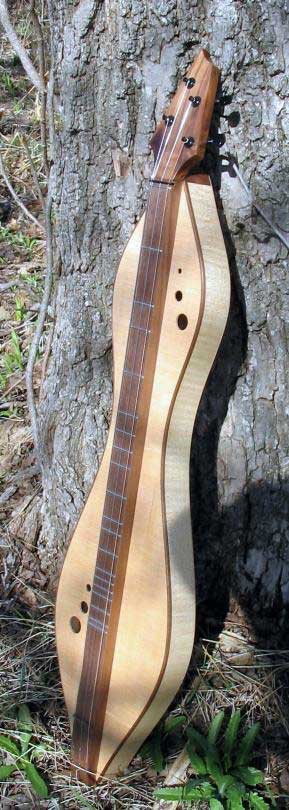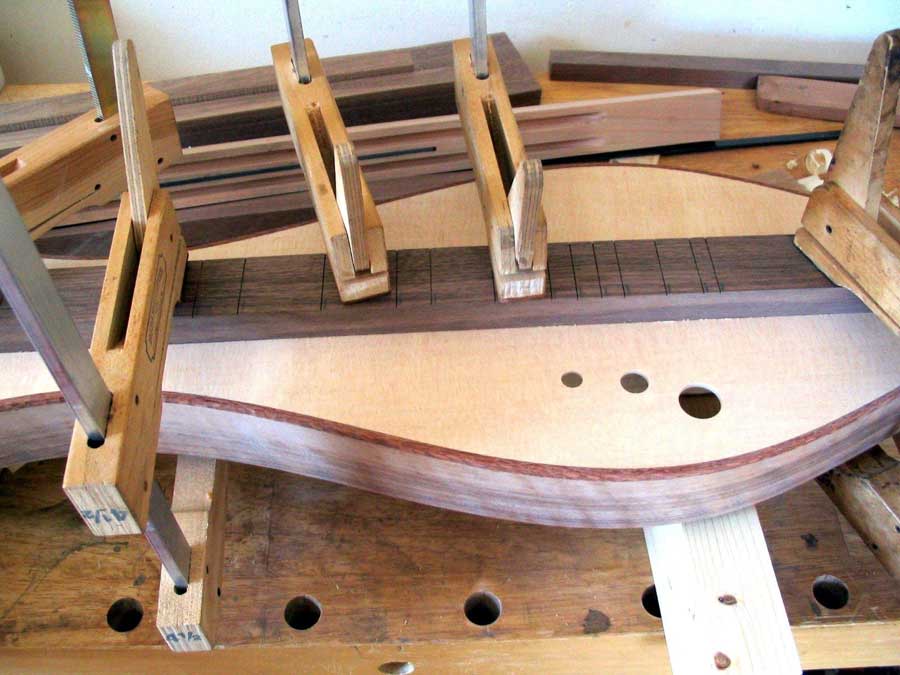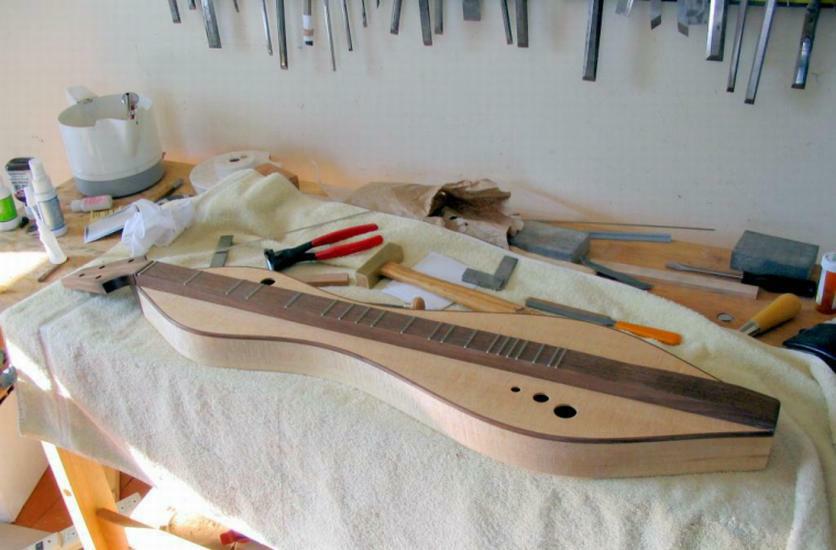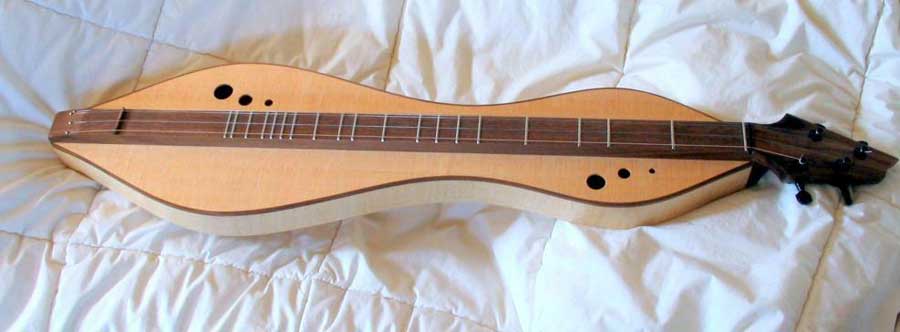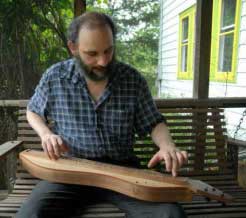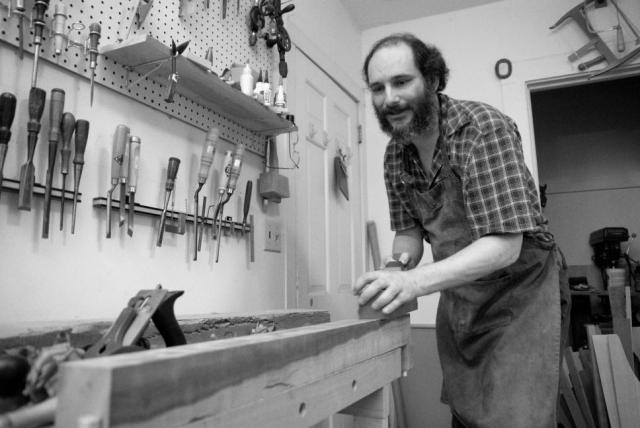
In the world of folk music, the guitar, fiddle and banjo are quick to grab center stage. However, if you are willing to wander the fringes of the genre, you may be lucky enough to stumble upon the placidly soothing song of the mountain dulcimer, a humble instrument with a uniquely American pedigree. One of the country’s foremost experts on both playing and building these unpretentious instruments is a modest, gentle man named Doug Berch.
“I had never done any woodworking until I started making dulcimers at the age of 17,” recalled Doug. “Basically, I was really into playing the mountain dulcimer. I lived in New York City, but even there the caliber of instruments I could find were not up to snuff to my demands. Furthermore, I felt that making your own dulcimer was an important part of playing it. Making music is ephemeral; you do it and it is gone, but making an instrument is the opposite. Making instruments provides the balance and ballast to the whole process.
“Of course, I did not make my first dulcimer. I got that when I was about 15. At that time, I was a member of a theater company working out of a small storefront owned by a church. I was the emcee, and one of our performers really opened me up to folk music. One night he showed up with a dulcimer. I was a rock and roll piano player, but I was immediately drawn to the dulcimer.
“After spending about a year looking all over the city, I bought a fairly inferior dulcimer and found out later that I spent way too much for it. The store had seem me coming and decided to take advantage of someone naïve. Still, it got a dulcimer into my hands, and I loved it.
“Twelve hours after I bought it, I was playing for drinks in a bar. In those days, the drinking age in New York City was 18. I kept at it and became very passionate about the instrument. I couldn’t find a teacher or books on it, so I figured it out myself. People were often amazed that I had done that, but remember, I had been a trained musician, and piano tends to teach you music structure as well.
“I still wanted to make my own, so I bought three or four dulcimer building kits from companies who sold them and built them on the kitchen table in my parents’ house. Putting them together taught me a lot about different approaches to building them in spite of the fact that I was using primitive tools: a coping saw, a dovetail saw and a handful of X-Acto® knives. In one of the kits was a complimentary copy of the Dulcimer Players’ News, which contained an ad for Gurian Guitars sawmill. They sold sawn dulcimer wood, so I decided to try it from scratch.
“My first bending iron, a heated pipe to bend wood, was a coffee can with a can of Sterno® inside. It did not get quite hot enough to actually bend the wood, so I topped it with a wet towel. The steam helped, but I could only do gentle bends; in fact, ones that were even too gentle for a dulcimer. Instead, I forced the sides into a form and glued them to the back and top. About an hour later, I heard a creaking sound and looked over in time to see it explode.
“My first few were fairly crude and pretty useless. They played, but not well. I sold them for 15 or 20 dollars each — just enough to buy more wood to try again. Meanwhile, I started reading books on lutherie, which were just coming out at that time. I learned the right way to bend wood as well as general information about how to build a box that sounds good and resists exploding.”
It was at this point, which was in the mid 1970s, that Doug and I first met. “I started going to local folk festivals where I was often the only dulcimer player,” Doug recounted, “but at one I met a guitar and dulcimer player who introduced me to Steve Uhrik and you.” At the time, Steve and I shared a luthiery shop in Soho along with a pipe organ builder and a harpsichord maker, and we invited Doug to come and use the shop, with its array of real woodworking tools, for free.
Soon after, Doug and I formed a musical duo, which later morphed into a trio, called The Gentle Grafters. We were dirt-poor and rather hungry, so we decided to try our luck playing at an inexpensive whole foods restaurant in Greenwich Village. After a time, the owner, who liked what he heard, sent over a bottle of wine. We sent it back, telling him, “We’re most grateful, but if it’s all the same to you, we’d rather have food.” He fed us and invited us to return whenever we liked, and we did, whenever we were hungry.
“After traveling around the country to festivals,” Doug continued, “I moved to Philadelphia for a couple of years, moved back to New York City for a year or so, then eventually ended up in Boulder, Colorado. I stopped building and focused on playing for the next 12 years. However, when you are in your 30s playing folk music, you soon envision yourself ending up in a career saying, ‘Would you like fries with that?’ To avoid that, I went visiting and ended up applying for a job at Elderly Instruments in Michigan. A month later, I was living there.
“During the job interview, I met a woman named Cynthia. We started seeing each other and got married a couple of years later. We are together still, and quite happy about it. I worked at Elderly for about 12 years running the CD sales department, and eventually ended up managing the showroom. Although I had constant exposure to great instruments and got to handle many, I did not do instrument repair or building there.
“About five years ago, I realized I missed making instruments too much, so I started acquiring tools, reading, and talking to the repair people at Elderly. Mostly I concentrated on really learning hand tool skills. Two years ago, I left my job to devote my time to instrument making and playing music exclusively, though my wife still works there. The economy started tanking about six months after I left Elderly. My wife recently asked me if I would have done anything differently had I known what was to come. I told her I might have, but frankly, I’m glad I didn’t know, since I was ready to leave.
“My initial thought was to work primarily with hand tools, but it did not turn out that way. As much as I love them, making a living at it demands I use at least some basic power tools. Still, about 75 percent of the work is with hand tools. Over the years, I’ve made hurdy-gurdies, psalteries and hammered dulcimers along with Appalachian or mountain dulcimers, which is what I am mostly making now. I’ve also recorded six albums, cassettes and CDs, the first one in 1983. That was the year I won first place in both hammered and mountain dulcimer at the national championships at Winfield, Kansas.
“I’m very lucky,” Doug admitted, “because I love what I am doing. I am always amazed when I play a completed instrument for the first time and realize that a part of a large plant has become something that makes music.”
